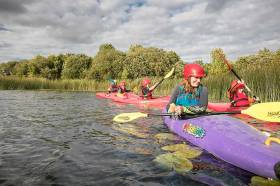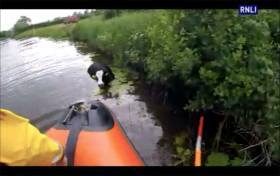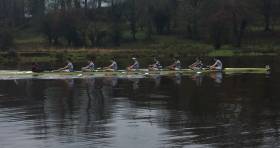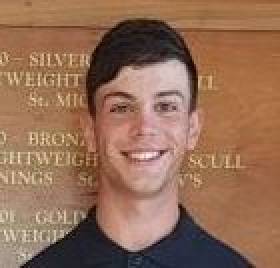Displaying items by tag: Enniskillen
Water Activity Zone Coming To Enniskillen Blueway
#InlandWaters - That new Enniskillen Blueway water activity zone located beside Erneside footbridge will be opening soon.
A range of family-friendly water activities including canoeing, kayaking and stand-up paddle boarding will be offered at the zone developed by Waterways Ireland with the support of Fermanagh & Omagh District Council, Fermanagh Lakeland Tourism and Enniskillen BID.
If you would prefer to captain your own boat and enjoy a leisurely experience around Ireland’s only island town, you might be more interested in one of the ‘wee red boats’ from Erne Boat Hire.
There is also a new heritage boat tour taking in the monastic and heritage sites around Enniskillen including Devenish Island, and the Erne Water Taxi for a more exhilarating blast around Lough Erne.
Waterways Irelad hopes the new water activity zone will play a role in encouraging young people to access the water, engage in water sports and make a connection with Lough Erne.
The activity zone also forms part of ongoing blueway developments on Lough Erne, the first of which will be a canoeing trail from Bellanaleck to Troy, taking in Enniskillen town and the new activity zone.
Carrybridge Lifeboat Rescues Cow In Distress
#RNLI - Just two days before Carrybridge RNLI’s new inshore lifeboat had its naming ceremony, boat and crew launched to assist a cow that had fallen from a steep bank on Upper Lough Erne.
The lifeboat and rescue water craft launched at 3.30pm on Thursday afternoon (7 June) arrived to the cow and its owner, who had been trying to recover the animal from the Arney River without success.
Weather conditions had southerly Force 2 winds, with good visibility and cloudy skies.
After speaking with the farmer, the volunteer crew kept the animal close to the bank and helped to steer the cow towards a part of the bank where it would be able to get out.
After some careful coaxing, the cow was assisted in getting out of the river by the crew and the farmer’s family. The crew were thanked by the owners and the lifeboat and rescue water craft departed the scene at 4.14pm.
Then on returning to station, the RNLI crew were requested to aid a vessel which had broken down nearby. The crew assisted in towing this boat back to its private slipway.
“We are always happy to help the local community in situations where there is risk to both the public and animals,” said Tom Bailey, lifeboat operations manager at Carrybridge RNLI.
“We also advise everyone working close to the edge of water to take the necessary precautions. In this instance we were delighted that the cow was able to be recovered without injury.”
Elsewhere, Enniskillen RNLI launched yesterday afternoon (Saturday 9 June) to assist a 23ft Bayliner that has lost engine power at the entrance into the River Erne which leads to Belleek.
The charity’s inshore lifeboat Joseph and Mary Hiley and rescue water craft arrived at the casualty vessel which had three people onboard, all of whom were safe and well.
The volunteer crew set up a tow to the lifeboat and towed the vessel to Aughinver.
Speaking following the callout, Enniskillen RNLI helm Aidy Kelly said: “It was a very successful recovery with our crew using the benefits of their winter training to recover the vessel and all onboard safely to Aughinver.”
Fermoy, Enniskillen and Bann Take Golds, Silver and Bronze at National Schools' Regatta
#Rowing: Irish crews took a full set of medals – gold, silver and bronze – in Championship finals on another excellent day at the British National Schools’ Regatta on Dorney Lake on Sunday. The Fermoy pair of Ellie O’Reilly and Gill McGirr powered away from their opponents in the second half of the Championship Pair A Final, while Enniskillen’s Nathan Timoney and Odhran Donaghy took a comfortable second in the men’s race. Aaron Christie of Bann held out well to hold on to third in the Championship Singles. Enniskillen also took a gold medal in the junior 16 girls’ pair, through Zoe McCutcheon and Maeve Donnelly.
British National Schools’ Regatta, Dorney Lake (Selected Results; Irish interest)
Saturday
Boys
Championship/Non-Championship Eight – B Final: 3 Enniskillen RBC.
Girls
Championship/Non-Championship Eight – B Final: 2 Galway 7:35.72; 3 St Michael’s 7:45.46.
Junior 16 Four, coxed – A Final: 2 Enniskillen RBC 8:22.68.
Sculling, Double – Championship A Final: 2 Workmen’s (A O’Donoghue, C Browne) 8:06.37.
Single – Championship A Final: 7 Workmen’s (C Moynihan) 9:10.40. B Final: 1 Coleraine Grammar School (M Curry) 8:43.03.
Sunday
Boys
Championship Pair: 2 Enniskillen (O Donaghy, N Timoney) 7:19.06.
Sculling, Championship Singles: 3 Bann (A Christie) 7:39.46.
Girls
Championship Pair: 1 Fermoy (E O’Reilly, G McGirr) 8:11.17.
Junior 16 Pair: 1 Enniskillen (M Donnelly, Z McCutcheon) 8:08.80
#Rowing: The Workmen’s junior women’s double took a silver at the National Schools’ Regatta at Dorney Lake in England today. In the Championship Doubles, Annie O’Donoghue and Ciara Browne finished one and a half lengths down on Latymer Upper School. Ciara Moynihan of Workmen’s finished seventh in the A Final of the Championship Singles, while Molly Curry of Coleraine Grammar School took control of the B Final and won.
Enniskillen took silver in the Boys’ Non-Championship Eights, and their girls’ junior 16 coxed four matched them in their A Final. Ireland clubs placed second and third in the B Final of the Girls’ Championship/Non Championship Eights.
British National Schools’ Regatta, Dorney Lake (Selected Results; Irish interest)
Saturday
Boys
Championship/Non-Championship Eight – B Final: 3 Enniskillen RBC.
Girls
Championship/Non-Championship Eight – B Final: 2 Galway 7:35.72; 3 St Michael’s 7:45.46.
Junior 16 Four, coxed – A Final: 2 Enniskillen RBC 8:22.68.
Sculling, Double – Championship A Final: 2 Workmen’s (A O’Donoghue, C Browne) 8:06.37.
Single – Championship A Final: 7 Workmen’s (C Moynihan) 9:10.40. B Final: 1 Coleraine Grammar School (M Curry) 8:43.03.
Doyle Top Sculler as Sam McKeown Turns to Britain
#Rowing: The under-23 lightweight pair of David O’Malley and Shane Mulvaney were the most emphatic of winners on the first day of the Ireland trial at the National Rowing Centre in Cork, while Philip Doyle won the men’s single sculls – in the absence of Queen’s University clubmate Sam McKeown, who has gone to the British system.
Emily Hegarty and Aifric Keogh teamed up well in a women’s pair and Monika Dukarska was untroubled in a fine win in the women’s single sculls. Sanita Puspure is overcoming a back injury and Aileen Crowley, who has partnered Keogh in a pair, has tendonitis. Denise Walsh has tonsilitis.
Andrew Goff was the best of a talented, ambitious, group of lightweight single single scullers.
The junior ranks were vibrant and drew praise from Ireland high performance director Antonio Maurogiovanni. Fermoy’s Eliza O’Reilly and Gill McGirr confirmed their preeminence in the women’s pair, while Enniskillen’s Odhran Donaghy and Nathan Timoney were the best junior men’s pair. Aoibhinn Keating of Skibbereen was the top junior women’s sculler and Jack Dorney looked strong as he raced away to win the junior men’s single.
Ireland Assessment, National Rowing Centre (Selected Results; senior results not published)
Men – Junior
Pair – A Final: 1 O Donaghy, N Timoney (Enniskillen) 7:30.94, 2 S O’Neill, W Ronayne (Shandon) 7:36.03, 3 O’Donovan, Mulready (Castleconnell) 7:48.19. B Final: P Murphy, J Kennedy (Enniskillen) 7:48.76. Single – A Final: 1 J Dorney (Shandon) 7:45.34, 2 J Keating (Carlow) 7:53.06, 3 A Byrne (Shandon) 7:54.13. B Final: T Murphy (Lee) 8:00.55.
Women - Junior
Pair – A Final: 1 E O’Reill, G McGill. Single – A Final: 1 A Keating (Skibbereen) 8:46.75, 2 R Carson (Bann) 8:50.84, 3 C Moynihan (Workmen’s) 8:54.71. B Final: C O’Brien (Castleconnell) 8:46.50.
#Rowing: Jack Dorney was an impressive winner of the Junior 18 men’s single sculls final at the Ireland Assessment at the National Rowing Centre today. The Shandon man moved into a clear lead by the 1500 metre mark and won well from Jack Keating of Carlow, who finished well.
Odhran Donaghy and Nathan Timoney of Enniskillen won the Junior men’s pairs final from Sam O’Neill and William Ronayne of Shandon, who gave them a good battle to the line.
The Fermoy women’s junior pair of Gill McGirr and Eliza O’Reilly also won well in the women’s junior pair, while Aoibhinn Keating of Skibbereen won an exciting final of the Junior women’s single.
#Rowing: Enniskillen RBC had two outstanding results at the Schools’ Head of the River in London. The girls’ eight won their category, the First Eights, and were fifth overall. The boys’ eight finished second in the equivalent category behind Bedford. When the revised results were published this placed them 10th overall, the best placing by an Irish crew at the event since 2010, when Bann Rowing Club finished ninth and 2011 when Portora (now Enniskillen) matched this. Enniskillen finished seventh in an event shortened due to weather in 2017.
Schools’ Head of the River, London (Selected Results; Irish interest; REVISED)
Men, Schools First Eight: 1 Bedford 17 min 15.1 sec; 2 Enniskillen Royal Boat Club (S Balcombe, R Mills, M McBrien, P Murphy, O Donaghy, J McDade, J Kennedy, N Timoney; cox: R Farragher) 17:18.4; 16 Methodist, Belfast A 19:10.2
First Junior 16 Eight: 9 Methody 19:44.4.
Sculling, Quadruple – Championship: 17 Methody 19:15.6.
Women, Schools First Eight: 1 Enniskillen RBC (T McComb, A Corry, V Wilson, C Leonard, Z McCutcheon, M Donnelly, J Long; C Fee; cox: S Dolan) 19:01.3; 13 Methody 21:49.7.
Trinity Keep Up Record of Wins at Erne Head
#Rowing: Trinity’s senior eight were the fastest crew at the re-fixed Erne Head of the River in Enniskillen today. It was their fourth consecutive win, achieved this year in rainy conditions. Junior crews did well: Enniskillen RBC’s junior men’s eight were third fastest overall and the fastest women’s crew was the host club’s junior eight.
In Amsterdam, UCC’s men’s eight were the best Irish crew at the Heineken Roeivierkamp. They took 32nd in the men’s race over 2,500 metres in seven minutes 36.8 seconds.
Erne Head of the River, Saturday (Selected Results)
Overall: 1 Trinity men’s senior eight 19 minutes 17 seconds, 2 Commercial sen eight 19:50, 3 Enniskillen jun eight 20:04, 4 Trinity inter eight 20:27, 5 Neptune club two eight 20:49, 6 Lagan senior quadruple 20:57: 17 Enniskillen women’s junior eight 22:39.
Men
Eight – Senior: Trinity 19:17. Inter: Trinity 20:27. Club Two: Neptune 20:49. Nov: Trinity A 21:26. Junior: Enniskillen 20:04. Masters: Commercial (D) 21:42. Jun 16: Col Iognaid 22:20.
Four – Jun, coxed: Commercial 22:35.
Sculling, Quadruple – Sen: Lagan Scullers 20:57. Inter: Belfast 21:53. Nov, coxed: Commercial 27:13. Jun: Neptune A 21:12. Jun 16, coxed: Bann 23:17. Masters, coxed: City of Derry (E) 24:31.
Women
Eight – Inter: Trinity 22:48. Club One: Bann 22:46. Club Two: Carlow 25:59. Jun: Enniskillen 22:39. Jun 16: Enniskillen A 23:53. Masters: Portora (D) 30:27.
Four – Sen: Trinity 24:25. Inter, coxed: Trinity 26:35.
Sculling, Quadruple – Jun: Col Iognaid 25:22. Jun 16, coxed: Carlow 25:08. Masters, coxed: City of Derry, Lagan, Offaly (C) 29:42.
Roeivierkamp, Amsterdam (Selected Result)
Men, 2500 metres: 1 Nereus 1e Eight 6:48.6; 8 Nereus 2e Eight 7:10.8; 32:UCC 2e Eight 7:36.8.
Fierce Weather Forces Erne and Cork to Postpone Heads
#Rowing: The two heads of the river scheduled for this Saturday have fallen foul of the weather, although both are set to be rescheduled. The Erne Head, at Enniskillen, had drawn a top-class entry. But while conditions at Enniskillen might well be rowable on Saturday, travel to the venue, especially on Friday, would prove difficult at best because of snow and high winds. The organisers hope to run the event on March 10th. Cork Head has also been cancelled, and organisers say the are also hoping to have it held on a new date.
Curry and Keating Top Double at Trial [UPDATE]
#Rowing: Molly Curry and Aobhinn Keating had the fastest time in a women’s double at the Ireland junior trial at the National Rowing Centre in Cork. The Coleraine Grammar School and Skibbereen combination covered the 2,000 metres in seven minutes and 45.13 seconds. We apologise for having got this wrong in the original report.




































































